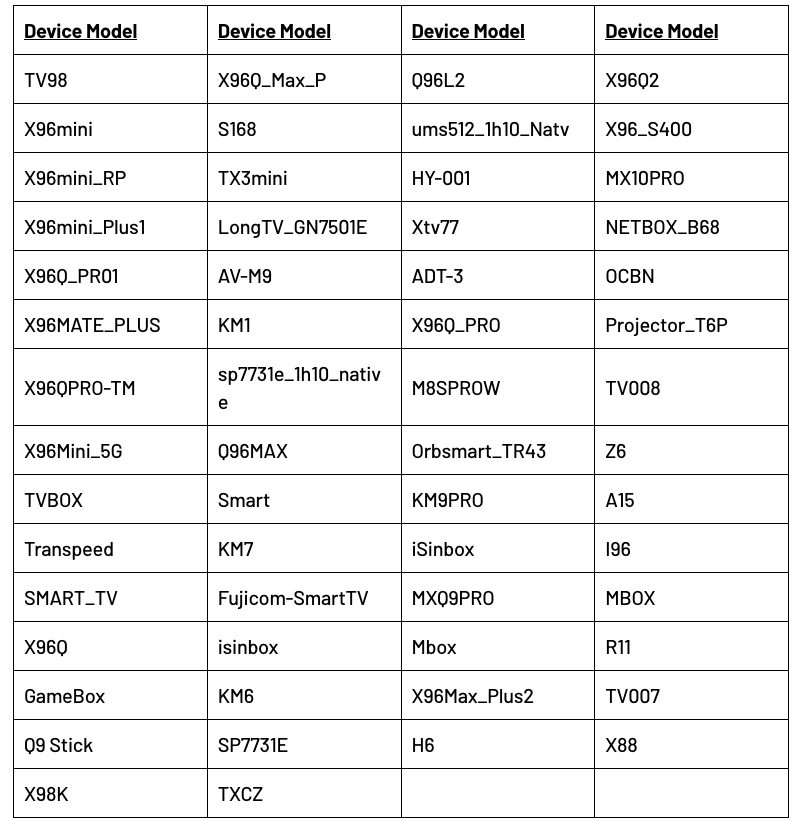On June 5th, the FBI released a PSA titled “Home Internet Connected Devices Facilitate Criminal Activity.” This PSA largely references devices impacted by the latest generation of BADBOX malware (as named by HUMAN’s Satori Threat Intelligence and Research team) that EFF researchers also encountered primarily on Android TV set-top boxes. However, the malware has impacted tablets, digital projectors, aftermarket vehicle infotainment units, picture frames, and other types of IoT devices.
One goal of this malware is to create a network proxy on the devices of unsuspecting buyers, potentially making them hubs for various potential criminal activities, putting the owners of these devices at risk from authorities. This malware is particularly insidious, coming pre-installed out of the box from major online retailers such as Amazon and AliExpress. If you search “Android TV Box” on Amazon right now, many of the same models that have been impacted are still up being sold by sellers of opaque origins. Facilitating the sale of these devices even led us to write an open letter to the FTC, urging them to take action on resellers.
The FBI listed some indicators of compromise (IoCs) in the PSA for consumers to tell if they were impacted. But the average person isn’t running network detection infrastructure in their homes, and cannot hope to understand what IoCs can be used to determine if their devices generate “unexplained or suspicious Internet traffic.” Here, we will attempt to help give more comprehensive background information about these IoCs. If you find any of these on devices you own, then we encourage you to follow through by contacting the FBI's Internet Crime Complaint Center (IC3) at www.ic3.gov.
The FBI lists these IoC:
- The presence of suspicious marketplaces where apps are downloaded.
- Requiring Google Play Protect settings to be disabled.
- Generic TV streaming devices advertised as unlocked or capable of accessing free content.
- IoT devices advertised from unrecognizable brands.
- Android devices that are not Play Protect certified.
- Unexplained or suspicious Internet traffic.
The following adds context to above, as well as some added IoCs we have seen from our research.
Play Protect Certified
“Android devices that are not Play Protect certified” refers to any device brand or partner not listed here: https://www.android.com/certified/partners/. Google subjects devices to compatibility and security tests in their criteria for inclusion in the Play Protect program, though the mentioned list’s criteria are not made completely transparent outside of Google. But this list does change, as we saw with the tablet brand we researched being de-listed. This encompasses “devices advertised from unrecognizable brands.” The list includes international brands and partners as well.
Outdated Operating Systems
Other issues we saw were really outdated Android versions. For posterity, Android 16 just started rolling out. Android 9-12 appeared to be the most common versions routinely used. This could be a result of “copied homework” from previous legitimate Android builds, and often come with their own update software that can present a problem on its own and deliver second-stage payloads for device infection in addition to what it is downloading and updating on the device.
You can check which version of Android you have by going to Settings and searching “Android version”.
Android App Marketplaces
We’ve previously argued how the availability of different app marketplaces leads to greater consumer choice, where users can choose alternatives even more secure than the Google Play Store. While this is true, the FBI’s warning about suspicious marketplaces is also prudent. Avoiding “downloading apps from unofficial marketplaces advertising free streaming content” is sound (if somewhat vague) advice for set-top boxes, yet this recommendation comes without further guidelines on how to identify which marketplaces might be suspicious for other Android IoT platforms. Best practice is to investigate any app stores used on Android devices separately, but to be aware that if a suspicious Android device is purchased, it can contain preloaded app stores that mimic the functionality of legitimate ones but also contain unwanted or malicious code.
Models Listed from the Badbox Report
We also recommend looking up device names and models that were listed in the BADBOX 2.0 report. We investigated the T95 models along with other independent researchers that initially found this malware present. A lot of model names could be grouped in families with the same letters but different numbers. These operations are iterating fast, but the naming conventions are often lazy in this respect. If you're not sure what model you own, you can usually find it listed on a sticker somewhere on the device. If that fails, you may be able to find it by pulling up the original receipt or looking through your order history.
A Note from Satori Researchers:
“Below is a list of device models known to be targeted by the threat actors. Not all devices of a given model are necessarily infected, but Satori researchers are confident that infections are present on some devices of the below device models:”
List of Potentially Impacted Models
Broader Picture: The Digital Divide
Unfortunately, the only way to be sure that an Android device from an unknown brand is safe is not to buy it in the first place. Though initiatives like the U.S. Cyber Trust Mark are welcome developments intended to encourage demand-side trust in vetted products, recent shake ups in federal regulatory bodies means the future of this assurance mark is unknown. This means those who face budget constraints and have trouble affording top-tier digital products for streaming content or other connected purposes may rely on cheaper imitation products that are rife with not only vulnerabilities, but even come out-of-the-box preloaded with malware. This puts these people disproportionately at legal risk when these devices are used to provide the buyers’ home internet connection as a proxy for nefarious or illegal purposes.
Cybersecurity and trust that the products we buy won’t be used against us is essential: not just for those that can afford name-brand digital devices, but for everyone. While we welcome the IoCs that the FBI has listed in its PSA, more must be done to protect consumers from a myriad of dangers that their devices expose them to.













